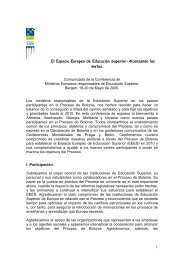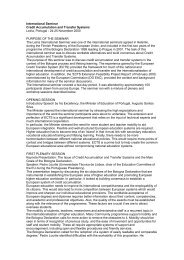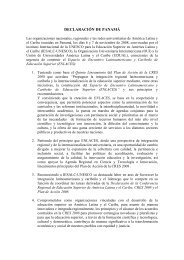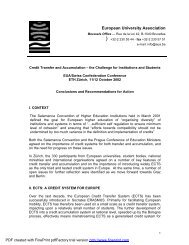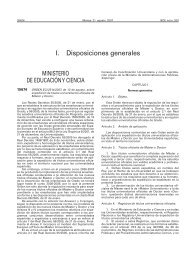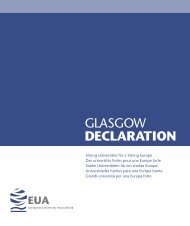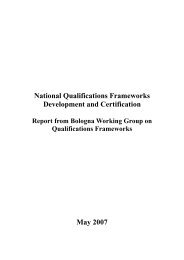New Zealand and the Bologna Process
New Zealand and the Bologna Process
New Zealand and the Bologna Process
Create successful ePaper yourself
Turn your PDF publications into a flip-book with our unique Google optimized e-Paper software.
5Background on <strong>the</strong><strong>Bologna</strong> <strong>Process</strong>The <strong>Bologna</strong> Declaration, agreed by 31 European Higher EducationMinisters from 29 countries on 19 June 1999, set in train <strong>the</strong> <strong>Bologna</strong><strong>Process</strong>. Participating European countries sought to create an integratedEuropean Higher Education Area (EHEA) by 2010, characterised byenhanced student, academic <strong>and</strong> labour mobility <strong>and</strong> greater ease ofcomparability of higher education systems.In spite of its voluntary nature <strong>and</strong> individual country implementation, <strong>the</strong><strong>Bologna</strong> <strong>Process</strong> has brought about more change in higher education inEurope than any o<strong>the</strong>r international instrument or policy. The <strong>Bologna</strong><strong>Process</strong> now involves 46 European countries <strong>and</strong> is increasingly likely tohave global implications in <strong>the</strong> field of higher education.The <strong>Bologna</strong> Declaration signatories are limited to those countries whichhave signed <strong>the</strong> Council of Europe’s European Cultural Convention (1954).The Thinking Behind <strong>the</strong> ReformsThe <strong>Bologna</strong> <strong>Process</strong> was initiated in an attempt to address perceivedweaknesses in <strong>and</strong> between European higher education systems. It soughtto improve student completion rates, <strong>the</strong> speed with which graduates couldenter <strong>the</strong> labour market, <strong>and</strong> academic <strong>and</strong> labour market mobility betweenEuropean countries. As <strong>the</strong> <strong>Process</strong> has developed, greater priority hasbeen given to student mobility, <strong>and</strong> most recently to <strong>the</strong> development ofglobal relationships.Towards <strong>the</strong> European Higher Education AreaThe <strong>Bologna</strong> <strong>Process</strong> seeks to create <strong>the</strong> EHEA by 2010. The EHEA is notintended as a unitary European system of higher education. Ra<strong>the</strong>r, it isa ‘space’ in which national systems possess common key features, in whichqualifications offered by institutions in <strong>the</strong> EHEA are easily recognised<strong>and</strong> assessed by institutions <strong>and</strong> employers for purposes of fur<strong>the</strong>r study oremployment, <strong>and</strong> in which <strong>the</strong>re is a high level of mobility by students<strong>and</strong> staff.Progress towards <strong>the</strong> creation of <strong>the</strong> EHEA is encouraged by biennialministerial meetings <strong>and</strong> officials groups.<strong>Bologna</strong> ProgressThe <strong>Bologna</strong> <strong>Process</strong> is progressed by biennial ministerial meetingsat which an official statement is agreed outlining priorities for <strong>the</strong>coming years.Sorbonne DeclarationThe precursor to <strong>the</strong> <strong>Bologna</strong> Declaration, <strong>the</strong> Sorbonne Declaration wasagreed by Higher Education Ministers from France, Germany, Italy <strong>and</strong> <strong>the</strong>United Kingdom on 25 May 1998. The Sorbonne Declaration laid <strong>the</strong>foundation for <strong>the</strong> <strong>Bologna</strong> <strong>Process</strong> by seeking <strong>the</strong> improvement of externalrecognition of national higher education systems to facilitate studentmobility <strong>and</strong> employability.




